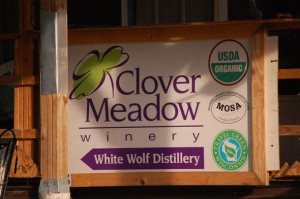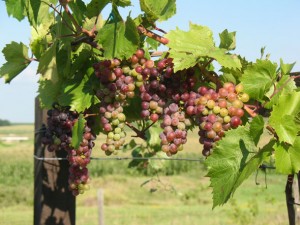Growing Organic Wine Grapes in The Midwest
Frontenac Grapes at Famous Fossil Winery, Freeport, Ill.
Until the Japanese beetles came, Famous Fossil Vineyard & Winery in Freeport, Illinois was certified biodynamic. That status changed in July, 2011, after Ken Rosmann discovered the first Japanese beetle in his vineyard. Millions more followed, and as organic sprays failed to control the beetles, Rosmann and his wife, Pam, were forced to relinquish their certification and treat the beetles with chemicals.
Their treatment of choice is Sevin, a 50-year-old pesticide spray that stays on the vines for seven days. Organic sprays that did kill the bugs didn’t remain on the plants and required constant application. ‘We only use the pesticide against the Japanese beetles,” Pam says, adding that they use the minimum amount required.
But it would take more than a few million beetles to end the Rosmanns’ commitment to sustainability. They’ve developed an integrated pest management approach, including a 30-percent vinegar solution that keeps pests from their younger vines. The Rosmanns’ also built “insectaries” or plant habitats for various insects that benefit the overall health of the vineyard. They also continue other sustainable practices, including composting, use of copper fungicide, and encouraging leaf hopper eating blue birds to nest.
Cliff Boomer, owner of Douglas Valley Vineyard in Manistee, Michigan, says his orchards have been USDA certified organic since 1990 and his vineyards now are certified as well–’but that leaves us only a few arrows in our quiver” in terms of controlling pests and disease.
Fortunately, Boomer doesn’t need as many ‘arrows” as most growers to keep his vines disease and pest free. He has an ally in the land itself: perched on the shores of Lake Michigan, his vineyards enjoy constant wind that dries the grapes, so mold isn’t much of a problem. The terrain is flat with few trees, so the wind blows freely. ‘Through no brilliance of our own, just because of where we are, we get to walk hand in hand with the land and with nature,” he says.
Still, Boomer does spray once a week as a precaution against botrytis and gray mold. He uses a classic Bordeaux mixture of copper sulfate and hydrated lime. He also struggles with damage by the Rose Chafer, a beetle that feeds not only on leaves but on the tiny fruits–but in a perverse way, he says, the Rose Chafer also helps his crop. ‘If the beetles take half my fruit, I have better air flow and spray penetration,” he says. ‘So to adjust, we leave more fruit on the vine. We know now that about a third of the berries won’t develop.
‘To some extent, nature manages itself,” he says, laughing. ‘The beetles do our thinning for us for two weeks, then they go away.”
 Clover Meadow Winery in Shell Lake, Wisconsin is managing to maintain its USDA certification as well, but their challenges are largely economic. ‘The certification itself is expensive,” says Alexia Gannon, chief operating officer of the winery, ‘but even more, growing organically is a labor-intensive effort. We have to physically put more people in the fields, pulling weeds and picking bugs off the plants. We raise honeybees to pollinate the plants, and we irrigate from our own pond that collects rainwater and snowmelt. It gets expensive.”
Clover Meadow Winery in Shell Lake, Wisconsin is managing to maintain its USDA certification as well, but their challenges are largely economic. ‘The certification itself is expensive,” says Alexia Gannon, chief operating officer of the winery, ‘but even more, growing organically is a labor-intensive effort. We have to physically put more people in the fields, pulling weeds and picking bugs off the plants. We raise honeybees to pollinate the plants, and we irrigate from our own pond that collects rainwater and snowmelt. It gets expensive.”
Gannon gave an example of one ‘hidden” cost of organic growing: the rolls of plastic used as ground cover to control weeds. ‘We need two rolls to cover two acres,” she says, ‘at about $250 per roll. But shipping costs are based on weight and because of our location, out here in rural Wisconsin, our $500 in plastic can cost $1,000 to ship.”
Still, the rewards are substantial, even if they do come at a price. ‘We know we’re doing the best we can for the environment,” Gannon says, ‘and for people who drink our wine. And we’re providing jobs locally, and buying supplies locally, and doing what we can for the community. That’s part of being organic, too.”
See related story: Sustainable Suggestions from Michigan’s Good Neighbor Vineyard
But at least one expert advises caution before committing to growing organic wine grapes. ‘I don’t want to come across as anti-organic,” says Professor Mike Ellis, PhD of Ohio State University’s Department of Plant Pathology. ‘But in Ohio, we’re wet and we’re warm. I don’t recommend organic fruit planting here.” Ellis recites five major diseases that attack grapes in the Midwest: black rot, powdery mildew, downy mildew, leaf spot and botrytis. In Wisconsin and Minnesota, the fungus anthracnose also is a problem for some growers.
‘I hate to be this negative. If someone comes to me, I’ll help them all I can. But I don’t recommend organic growing [in this region], and I would not invest my personal money in it.”
For growers who do want to pursue organic certification, Ellis offers advice on his website, www.oardc.ohio-state.edu/fruitpathology. Guidelines for disease management, pest control, and a book-length guide to growing grapes in the Midwest all can be downloaded. Ellis works closely with the OSU Extension Service and provides links to their resources as well.
The USDA issues a long list of strict guidelines for organic pest and disease management. Allowable organic practices include introduction of parasites and predators for pest control, nonsynthetic controls such as lures and traps, mulching with biodegradable materials and flame and hand weeding.
‘I would love to hear more people talking about this,” Pam Rosmann says. ‘We feel pretty isolated about growing organically–it’s just not discussed in the winery business in the Midwest.”
She also wants her fellow growers to know it’s not difficult to incorporate sustainable practices, such as spraying plant-based herbicides and fungicides, into vineyard management. ‘We’re not opposed to synthetics,” she says. ‘It’s the overuse and misuse that we object to. Chemical spraying became the best choice for our business and for our plants–and we’re grateful that there were very benign insecticides available to us.”
Publisher’s note: Mike White from Iowa State University also has good advice for organic grape growers. Mike’s organic growing tips and cautionary tales are at: extension.iastate.edu.
Photos courtesy of Pam Rosmann at Famous Fossil Vineyards, Freeport, IL






We live in north central Illinois on a 3/4 acre homestead. The first year we were here, Japanese beetles ate everything that we would have liked to can for the winter! We ordered up a dozen Ancona ducklings, and have never had any issues since. Granted, this may not work for folks with hundreds or even tens of acres, as you have to keep the ducks from getting to your grape vines, etc.; we use bird netting to wrap them up (The grape clusters, not the ducks), but you never saw such happy, well-fed creatures as those ducks during beetle season. Let them out at dawn, and watch them gobble down beetles that are torpid, on low vegetation or on the ground, as the sun hasn’t warmed the bugs into alert/speedy mode yet. The ducks also do a fabulous job on your weeds, and they never whine about the work, call in sick, or ask for a raise; they give you eggs as a thank-you for all the delicious forage you give them. They don’t scratch the ground around your vines the way chickens do; and another bonus: Ducks are hilarious to watch; such personality. Television drama pales in comparison.
Thanks for sharing, what a great way to take care of Japanese beetles.